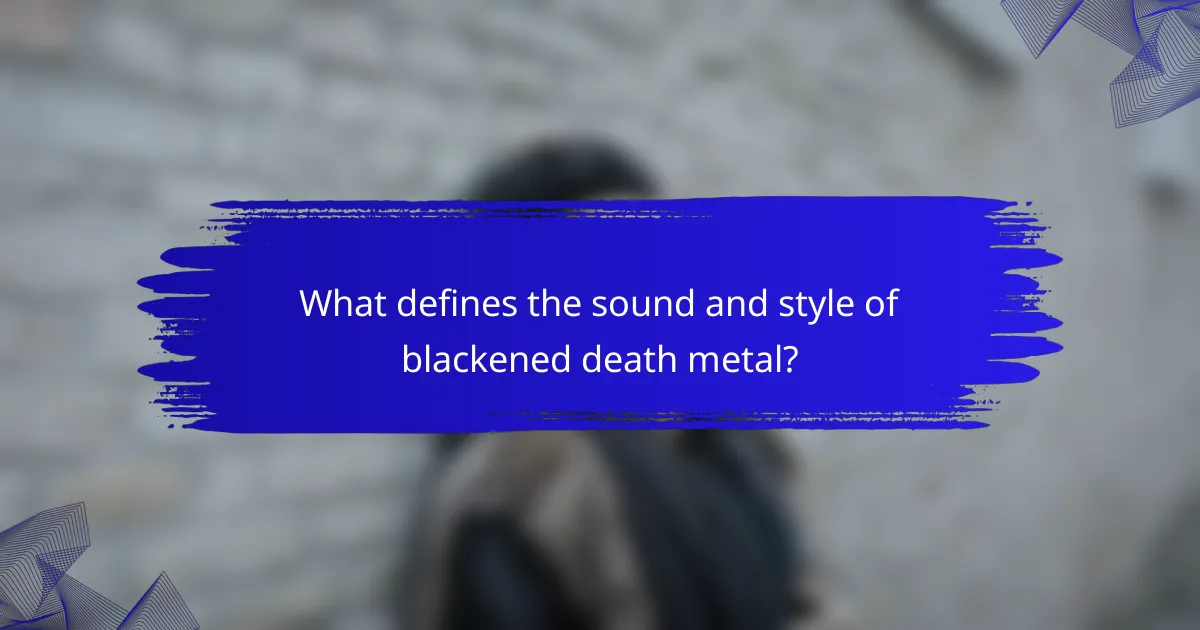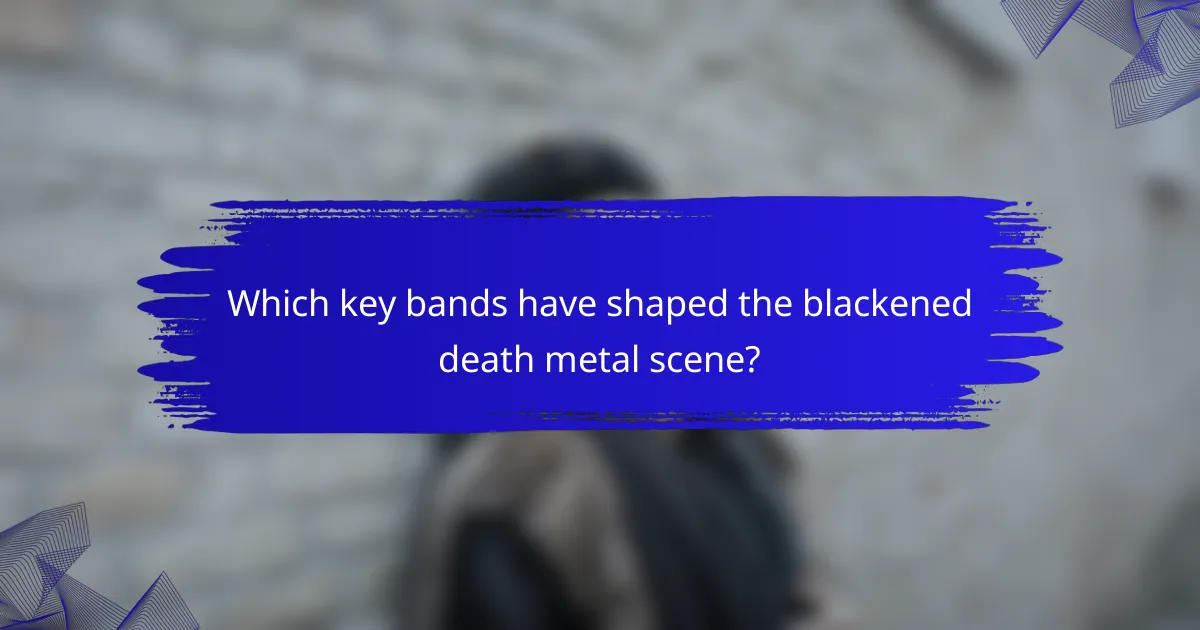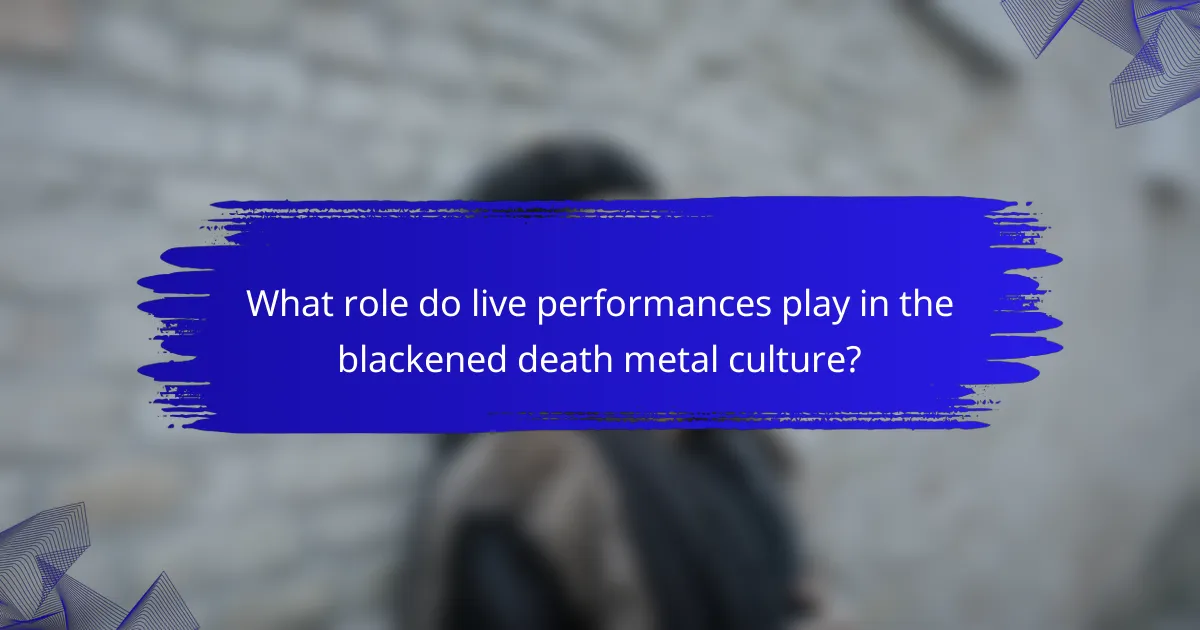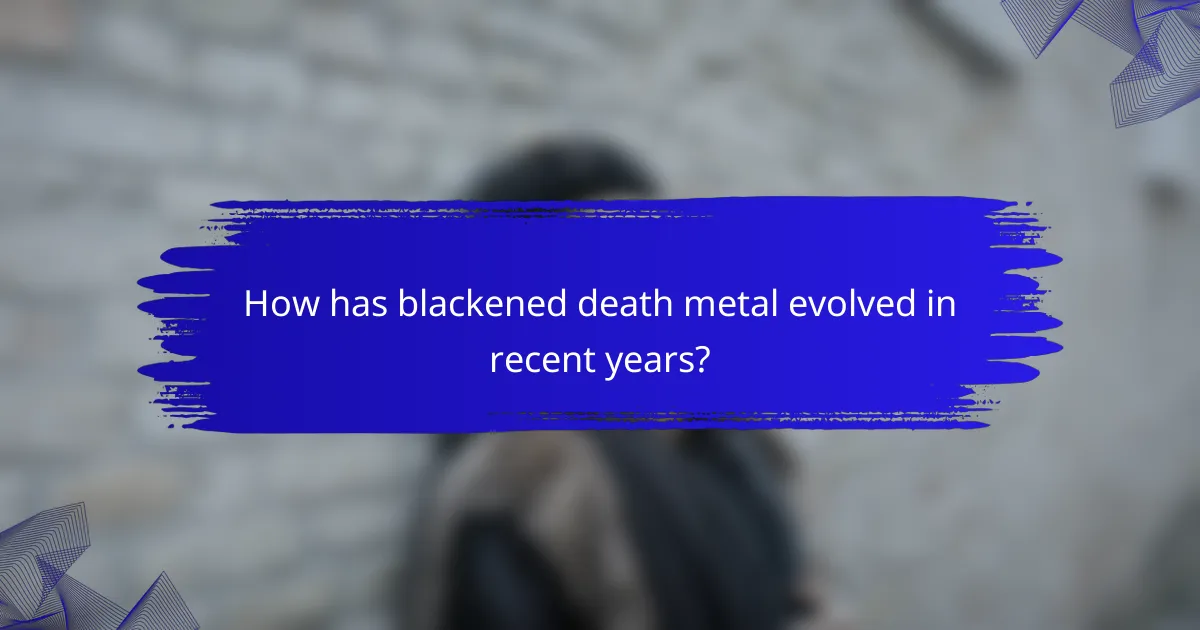Blackened death metal captivates fans with its aggressive riffs and atmospheric elements. This article explores its key features, influential bands like Behemoth and Dissection, and notable releases such as “The Satanist.” Additionally, it examines common misconceptions and the genre’s evolution through experimentation and live performances. Discover how this unique fusion continues to shape the metal landscape.

What defines the sound and style of blackened death metal?
Blackened death metal combines elements of black metal and death metal, characterised by aggressive riffs, shrieking vocals, and atmospheric elements. Key features include fast-paced drumming, dark lyrical themes, and a raw production style. Notable bands like Behemoth and Dissection exemplify this genre, with significant releases such as “The Satanist” and “Storm of the Light’s Bane.” This fusion creates a unique sound that appeals to fans of both metal subgenres.
How do musical elements contribute to its unique identity?
Musical elements significantly shape the unique identity of blackened death metal. The genre blends aggressive riffs, blast beats, and atmospheric elements, creating a dense soundscape. Unique attributes include the use of dissonant chords and shrieking vocals, which evoke a dark, foreboding atmosphere. Key bands like Behemoth and Dissection exemplify these features, incorporating symphonic and melodic elements that enhance their sonic identity. Notable releases, such as “The Satanist” by Behemoth, showcase intricate compositions that further define the genre’s distinctiveness.
What lyrical themes are prevalent in blackened death metal?
Lyrical themes in blackened death metal often explore darkness, despair, and existentialism. Common subjects include mythology, horror, and anti-religious sentiments. These themes reflect a unique blend of aggression and atmosphere, enhancing the genre’s overall intensity. Bands like Behemoth and Dissection exemplify these lyrical approaches, incorporating vivid imagery and philosophical concepts.

Which key bands have shaped the blackened death metal scene?
Key bands that have shaped the blackened death metal scene include Behemoth, Dissection, and Dark Funeral. These bands are known for their fusion of death metal’s intensity with black metal’s atmospheric elements. Behemoth, for example, has significantly influenced the genre with their unique sound and theatrical performances. Dissection’s “Storm of the Light’s Bane” is a landmark album that exemplifies the style, blending melodic riffs with aggressive vocals. Dark Funeral’s relentless energy and dark themes have also left a lasting impact on the scene.
What are the defining characteristics of influential bands?
Influential bands in blackened death metal are characterised by their fusion of extreme metal styles, dark themes, and complex compositions. Key features include aggressive instrumentation, growled vocals, and atmospheric elements. Notable bands like Behemoth and Dissection exemplify these traits with their innovative sound and lyrical depth. Significant releases, such as Behemoth’s “The Satanist,” showcase the genre’s evolution and impact on metal music.
How do regional variations impact band styles and sounds?
Regional variations significantly influence blackened death metal styles and sounds through cultural, geographical, and historical contexts. Different regions contribute unique elements to the genre, resulting in distinct tonal qualities and lyrical themes. For example, Scandinavian bands often incorporate atmospheric elements, while American bands may emphasise aggression and technicality.
Key bands such as Behemoth from Poland blend black metal influences with death metal, showcasing unique attributes like intricate guitar work and philosophical lyrics. Similarly, bands like Bloodbath from Sweden highlight a raw sound that reflects the region’s death metal roots.
Notable releases further illustrate these variations. “The Satanist” by Behemoth emphasises a blend of orchestral and brutal elements, while “Nightmares Made Flesh” by Bloodbath showcases a more traditional death metal sound with blackened undertones. Thus, regional influences create a rich tapestry within blackened death metal, shaping its evolution and diversity.

What notable releases have defined the genre’s evolution?
Notable releases that have defined blackened death metal include “The Somberlain” by Dissection, “Storm of the Light’s Bane” by Dissection, and “Dark Endless” by Marduk. These albums showcase the genre’s fusion of melodic elements and aggressive instrumentation, establishing a distinctive sound. Key bands like Behemoth and Belphegor have further evolved the style, introducing unique attributes such as complex song structures and thematic depth. The genre continues to thrive, influenced by both traditional death metal and black metal roots.
Which albums are considered essential listening for fans?
Essential albums for blackened death metal fans include “The Somberlain” by Dissection, “Storm of the Light’s Bane” by Dissection, “Fallen” by Behemoth, “The Infernal Pathway” by Abbath, “Marduk” by Wormwood, and “The Black Flame” by Dark Funeral. These releases showcase the genre’s defining characteristics and influential sound.
How have production techniques influenced notable releases?
Production techniques have significantly shaped notable blackened death metal releases by enhancing sound complexity and atmosphere. Advanced recording methods, such as digital production and layering, have allowed bands to create a more immersive experience. For instance, the use of reverb and distortion has intensified the genre’s characteristic dark and aggressive sound.
Key bands like Behemoth and Dissection have utilised these techniques to craft albums that are both sonically rich and thematically profound. Their innovative approaches to instrumentation and vocal layering have set benchmarks within the genre. As a result, notable releases like “The Satanist” and “Storm of the Light’s Bane” exemplify how production choices can elevate artistic expression.
Moreover, the integration of orchestral elements and ambient soundscapes in certain albums showcases a unique attribute of blackened death metal. This blending of genres has attracted a broader audience, proving that production techniques can influence not just sound but also the genre’s evolution.

What are the common misconceptions about blackened death metal?
Common misconceptions about blackened death metal include its perceived lack of melody and its association solely with extreme themes. Many believe it is just a fusion of black metal and death metal without distinct characteristics. In reality, blackened death metal features intricate melodies, atmospheric elements, and diverse lyrical themes that extend beyond typical genre boundaries. Key bands like Behemoth and Immolation showcase these attributes, blending aggression with musical complexity. Notable releases, such as “The Satanist” by Behemoth, further illustrate the genre’s depth and artistic merit, challenging simplistic views.
Why is the genre often misunderstood by mainstream audiences?
The genre is often misunderstood due to its complex sound and aggressive themes. Blackened death metal combines elements of black metal and death metal, creating a unique auditory experience. This fusion can alienate mainstream audiences accustomed to more straightforward genres. Additionally, lyrical content often explores dark and philosophical themes, which may not resonate with casual listeners. Key bands like Behemoth and Dissection exemplify this complexity, contributing to the genre’s niche appeal.
How does the community address stereotypes surrounding the genre?
The community actively challenges stereotypes in blackened death metal by promoting diversity and inclusivity. Key bands and artists are increasingly highlighting their unique backgrounds, which enriches the genre. This shift encourages a broader acceptance of varied influences, breaking down preconceived notions. Notable releases showcase these diverse perspectives, reinforcing the idea that the genre is not monolithic but rather a tapestry of different experiences and styles.

What role do live performances play in the blackened death metal culture?
Live performances are central to blackened death metal culture, providing a visceral experience that enhances community and energy. These events showcase the genre’s intensity through elaborate stage setups, powerful musicianship, and a dedicated fan base. Key bands like Behemoth and Bloodbath often incorporate theatrical elements, deepening audience engagement. The atmosphere at these shows fosters a unique connection between performers and fans, creating memorable experiences that define the genre’s identity.
How do festivals and tours contribute to genre popularity?
Festivals and tours significantly enhance the popularity of blackened death metal by fostering community engagement and showcasing key bands. These events create immersive experiences that attract new listeners and energise existing fans. For example, renowned festivals like Maryland Deathfest and Hellfest feature prominent blackened death metal acts, leading to increased visibility and album sales. Additionally, tours allow bands to reach diverse audiences, expanding their fan base and influence. The synergy between live performances and genre exposure plays a crucial role in the overall growth of blackened death metal.
What unique experiences do fans have at blackened death metal shows?
Fans at blackened death metal shows experience a unique blend of intense atmosphere, immersive soundscapes, and community engagement. The dark, aggressive music creates a visceral connection among attendees, fostering a sense of belonging. The theatrical elements, such as elaborate stage setups and dark imagery, enhance the overall experience. Unique interactions with band members during meet-and-greets or Q&A sessions add personal value. Additionally, the sense of camaraderie among fans, often seen in mosh pits and collective singing, creates lasting memories.

How has blackened death metal evolved in recent years?
Blackened death metal has evolved through increased experimentation and blending with other genres. The fusion of atmospheric elements and technical proficiency has become prominent. Key bands like Behemoth and Bloodbath have pushed boundaries with notable releases that showcase this evolution. Recent albums reflect diverse influences, enhancing the genre’s complexity and appeal.
What trends are emerging in the genre as of 2025?
Emerging trends in blackened death metal as of 2025 include increased fusion with other subgenres and a focus on atmospheric elements. Key bands are experimenting with diverse instrumentation, creating a richer sound. Notable releases showcase a blend of traditional black metal aesthetics with death metal’s aggression, appealing to a broader audience. The lyrical themes are evolving to include more existential and philosophical topics, reflecting contemporary societal issues.
Which new bands are gaining recognition in the blackened death metal scene?
Several new bands are gaining recognition in the blackened death metal scene, including Blood Incantation, Necrot, and Tomb Mold. These groups are noted for their innovative sound and compelling releases. Blood Incantation’s “Hidden History of the Human Race” showcases their unique blend of atmospheric elements and aggressive riffs. Necrot’s “Mortal” has received acclaim for its raw intensity and dark themes. Tomb Mold’s “Planetary Clairvoyance” features intricate songwriting and a distinct sonic identity. Each of these bands contributes to the evolving landscape of blackened death metal, attracting a growing fanbase.
What best practices should new listeners adopt when exploring blackened death metal?
New listeners should immerse themselves in the genre’s unique sound and themes. Start by exploring key bands like Behemoth and Immolation, known for their distinctive styles. Listen to notable releases such as “The Satanist” and “Close to a World Below” to understand the genre’s depth. Engage with online communities for recommendations and discussions to enhance your experience. Lastly, attend live shows to appreciate the energetic atmosphere and connect with fellow fans.